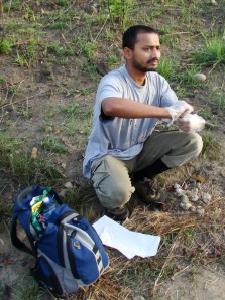Samrat Mondol
This project targets to assess the physiological consequences of nutritional and psychological stress in wild tigers. We also aim to evaluate the effect of these disturbances on their reproductive status and how such impacts vary with gender and habitat protection status.

Samrat.
Burgeoning human interventions in the form of habitat degradation, prey depletion and hunting have resulted in population decline in all predatory carnivores across the globe. Currently predatory carnivores are among the most threatened species globally. While habitat destruction, hunting and human-animal conflict are currently considered as major concerns, the physiological and reproductive impact of environmental disturbances has received little attention.
The tiger (Panthera tigris) represents one such endangered large carnivore globally. The Indian subcontinent currently harbours ~60% of global wild tiger populations, although anthropogenic impacts have precipitated a decline of 90% of all tigers during the last 200 years. Reduced to only 7% of their historical habitats, the survival and persistence of the residual tiger populations depends on effective conservation measures. Apart from efforts targeting local population recovery and maintaining connectivity among regions, future conservation strategies also need to address the impacts of growing pressures from habitat fragmentation, prey depletion and other disturbances to ensure the long-term survival of tigers across their range. Significant efforts have been made to increase local population size and connectivity among populations. However, to date no attempts have been made to understand the underlying impacts from human population pressure on the health and reproductive functions of any large cats.
Physiological measures of nutrition, stress and reproduction provide powerful indices of environmental pressures impacting wildlife health that can guide mitigation efforts. In this study, I plan to combine field and laboratory-based non-invasive faecal hormone measures to assess disturbance impacts from human use of the landscape and prey depletion on tiger resource selection and associated physiological stress and reproductive status in the Mysore-Malenad tiger landscape, Western Ghats, India. Disturbances vary in degree and form across the different tiger reserves and national parks in this area, making comparisons between areas ideal for monitoring anthropogenic impacts.
We will survey and collect fresh faecal samples from the entire Western Ghats landscape during different seasons over the year. Glucocorticoid and thyroid hormones from the faecal samples will be used to index psychological and nutritional stress, while gonadal hormones (e.g. progestens and androgens) will index reproductive status. DNA-based gender assignment from samples will enable us to also explore sex-differences in these disturbance impacts.
The survival of tigers is under tremendous pressure from habitat fragmentation and other human disturbances. Correlating these pressures with their physiological consequences provides timely information that can adaptively guide mitigation aimed at tiger conservation, providing the needed tools to monitor mitigation success and modify practices as needed.